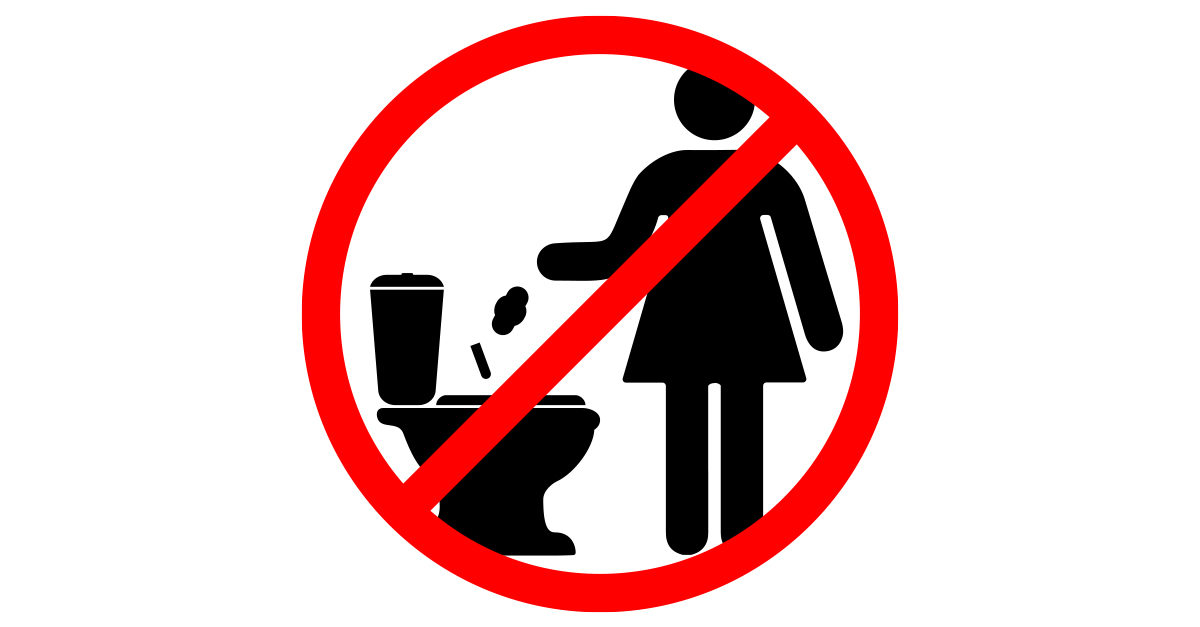Water and public works department websites of cities worldwide often include advisories that suggest ways customers can avoid water backup problems and prevent blockages and other sewer-related issues. Although each department may have specific recommendations, it appears that one piece of advice is suggested over and over again to protect sewers and avoid plumbing problems: Do not flush sanitary napkins down toilets.
Danger of Improper Disposal
Repeatedly, these websites indicate that sanitary napkins and disposable diapers are the two major causes for water line backups. And if the sewer is blocked, the costs to repair it can be steep and often fall on the property owner.
Some towns even recommend that property owners “carry specific insurance that covers the costs and damages related to sewage backups as a result of improper sanitary napkin disposal.” Additionally, when feminine hygiene products and sanitary napkins are flushed down the toilet, they can pollute streams and rivers, cause hormonal changes in wildlife, and enable harmful organisms to enter the food chain. Further, even though some manufacturers claim their napkins are soluble (will disintegrate), many if not most are only partially biodegradable.
Dealing with the safe and sanitary disposal of feminine hygiene products offers building service contractors (BSCs) profitable opportunities and in-house supervisors a way to reduce budgets and impress upper management.
Hygiene Issues
By the 1980s, disposable sanitary napkins were developed that were not as thick, were more comfortable for users, and were more absorbent and effective compared to previous products. However, calling them sanitary is a bit of a misnomer; they are sanitary when first used, but because the napkin is usually in use for a period of time, they become a breeding ground for harmful bacteria and germs by the time it comes to disposing of them. And while new technology has continued to advance in more recent decades, allowing even greater user comfort, there has been relatively little improvement in proper disposal. This is in part due to the sensitive nature of the subject for many users who, rather than search for a better option that may not be immediately available, continue to dispose of the products by flushing them down the toilet.
Over the years, various treatments have been applied to combat the growth of harmful bacteria, reduce odors while in use, and keep sanitary napkins more hygienic. However, in some cases, this has compromised comfort and caused irritation. And still today, there is no known manufactured chemical or natural-ingredient treatment that has proven to effectively reduce or inhibit the growth of bacteria in the napkins for a prolonged period of time. This is why women must be sure to wash their hands thoroughly after removing sanitary napkins—and cleaning professionals must be especially careful in how they handle and dispose of them.
Disposal Issues
While it is increasingly promising to see more and more cleaning professionals wearing gloves while performing their duties, it is still not uncommon to see cleaning workers not wearing protective clothing. Many public restrooms still have the ‘swing top’ dispensers or side-of-the-stall hanging receptacles for feminine hygiene products, and too often these do not have liners, so the cleaning professional must pick them up to empty their contents. The problem with this procedure, especially if gloves are not worn, is not only that the napkins are covered with bacteria, but the lip of the dispenser becomes soiled and often contaminated with potential blood-borne pathogens. This can prove harmful to the custodial worker, and to subsequent users of the dispensers as well, especially if the containers are not emptied or cleaned regularly.
More Hygienic Alternatives
In recent years, new products and technologies have been introduced that make the disposal of feminine hygiene products and sanitary napkins safer for local water departments. Similar to other, more advanced restroom technologies, many of these products incorporate no-touch technology. Neither the user nor the custodial worker actually touches the lid to use the device or to service it. For instance, one system has a foot-pedal that opens and closes the dispenser. Another system uses infrared sensor technology to open when needed.
By eliminating touching, such systems reduce the possibility of cross-contamination and are much more sanitary for the user and the cleaner. Similarly, new modes of deodorization, such as those within the liners and auto release, also add to increased hygiene.
Ultimately, these new, no-touch technologies and restroom services can only do so much. It is up to facility managers to assure sanitary disposal receptacles are conveniently located and it is up to restroom patrons to do their part to protect public health by disposing of these items properly as well.
This article was reviewed and updated May 18, 2018 from its original post September 19, 2010.



